Northumberland Village Homes for Girls, Whitley Bay, Northumberland
The Northumberland Village Homes for Girls were established in 1879, largely through the efforts of Mr James Hall of Newcastle, 'for the reception and training of little girls who are orphans or destitute, or who are found wandering and not having any home or settled place of abode, or proper guardianship, or visible means of subsistence.'
The establishment adopted the cottage homes system, with each home occupied by a 'family' group of ten to fifteen girls under the supervision of a house-mother. The homes were constructed on a site provided by the Duke of Northumberland, off Norham Road, Whitley Bay (then known just as Whitley or Whitley-on-Sea). The initial costs were paid for by private donations and subscriptions, with individual homes bearing their benefactor's name or other motto. The cottages were built in semi-detached pairs, each home having a general living room for the children, kitchen (also used as private sitting room for the mother), scullery, pantry, coal-house, and outside facilities; and on the upper floor were three good-sized bedrooms. The rooms were warmed by a hot-water apparatus situated in the centre outside of the block, and serving for both houses. Each kitchen was fitted with a close fire range, and a self-supplying hot water boiler. In the scullery was also a large copper for washing purposes, and for supplying the baths, one of which was fitted in each house.
On June 6th, 1879, the Homes were certified as an Industrial School, allowing them to receive girls placed under detention by magistrates, as well as voluntary cases. Although mixed Industrial Schools were already in operation in the area, at Newcastle and Gateshead, part of the motivation for opening the Homes was to provide a single-sex establishment where girls were believed by some to do far better. The Homes' accreditation as an Industrial School also allowed it to receive government funding for girls who had been committed by the courts. The Homes came into practical operation in June 1880 and by the end of that year, there were ten inmates under detention. The first house-mother or 'matron' to be appointed was Mrs Hannah Craig, joined soon afterwards by Mrs Groom. Overall superintendence of the Homes was exercised by the vicar of Whitley, the Rev. F.R. Wheeler.
A second pair of cottages was opened in 1882, providing accommodation for another 32 girls. A neighbouring cottage was also being rented for some of the younger children. A third matron, Miss Moor, was now appointed, with Miss Sheckel as an assistant matron.
A further block of cottages was completed in 1883, and construction was begun of a large schoolroom. In the meantime, the girls attended local public elementary schools. The staff now comprised: matrons Mrs Craig, Mrs. Groom, Mrs Moor, Mrs Simpson, Mrs Scott, Miss Sheckel, and Miss Stewart; assistant matrons Miss R. Sheckel and Miss Moor; teacher, Miss A. Giles; assistant teacher, Miss Gow.
All the girls were trained for domestic service and taught plain needlework and knitting. The older girls assisted in the laundry and in general housework and cooking. Two of the older girls in each cottage assisted the house-mother.
1884 saw the addition of a fourth block of two cottages, built at the cost of Mr and Mrs R.S. Donkin of North. Shields The accommodation now consisted of eight cottages in four blocks. In the same year, five girls emigrated to Canada and were placed out in situations.
The School site is shown on the 1919 map below.
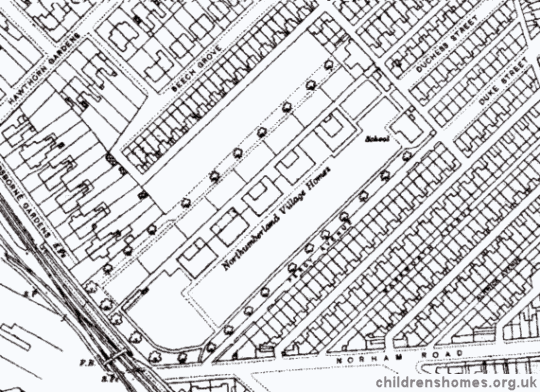
Northumberland Village Homes Industrial School for Girls site, Whitley-on-Sea, c.1919.
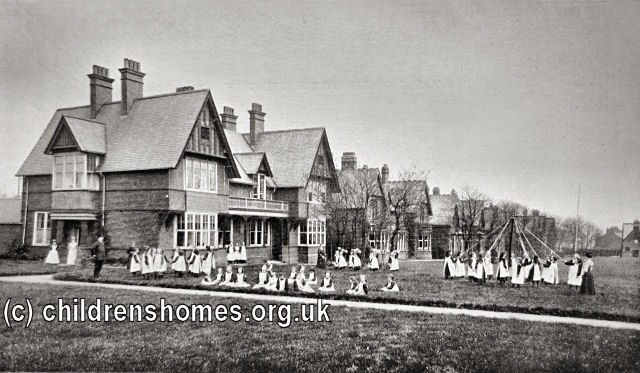
Northumberland Village Homes for Girls from the south, Whitley-on-Sea, early 1900s. © Peter Higginbotham

Former Northumberland Village Homes for Girls — Donkin Home from the east, Whitley-on-Sea, 2013. © Peter Higginbotham
The new school-room, at the north of the site, also came into operation in 1884.
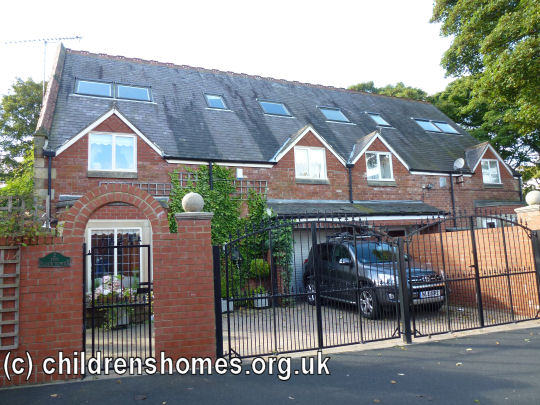
Former Northumberland Village Homes for Girls school-room from the north-east, Whitley-on-Sea, 2013. © Peter Higginbotham
By 1887, Mrs Craig had become overall superintendent of the Homes. House matrons at that date comprised Miss Stewart, Miss Taylor, Miss Scott, Miss Pattison, Miss Laidman, Miss Hall, and Mrs Gow. The schoolmistress was Miss Wright, assisted by Miss Davison. During that year, Mrs Craig went to Canada with nine girls, and left them all in good places, where they were said to be doing well.
In 1889, construction of a fifth pair of cottages was begun. One of the existing cottages was also fitted up for use as an infirmary. A strip of land close to the rear of the cottages was bought for £1,000 and made into a kitchen garden.
A report in 1896 noted that the establishment now comprised ten semi-detached cottages, one occupied by the superintendent, one used as the infirmary, and the remaining eight accommodating from 12 to 16 children. The cottages were clean and airy, but the working-class household with which they compared would be a somewhat luxurious one. There were detached buildings for school and laundry. The cottages were arranged along one side of a spacious lawn and garden. The girls were trained for domestic service and, since the new laundry was opened, as laundry-minds. Each house matron was responsible for the needle work and knitting for the household. An effort was made in each cottage to teach the older girls the duties of parlour-maid, similarly the older girls in each cottage assist the mother in plain cooking, including bread-making. Most of the girls went out as kitchen-maids. Less emigration had taken place of late, as local employment provided sufficient opportunities. The girls had the ran of the lawn and garden. In the schoolroom musical drill was given, and walks were frequently taken by the seaside. Some of the older girls went out in the neighbourhood on messages in connection with the laundry. In the summer the girls were able to bathe in the sea three or four times a week. Girls are not allowed to visit their own homes, except for reasons such as the serious illness of a near relative. However, their friends were allowed to visit the girls once in three months. As regards school performance, composition was rated as 'good', recitation and singing by ear as 'very fair', and mental arithmetic and geography as 'fair'. Corporal punishment was hardly ever resorted to, and the girls were encouraged to report to the superintendent any instance of irregular slapping. Deprivation of privileges and the more pleasant part of a meal, or being sent to bed in playtime, were the usual forms of punishment. There is a mark system in use in all departments of the school, with small monetary rewards for good conduct. Prizes were given for domestic work and progress in school.
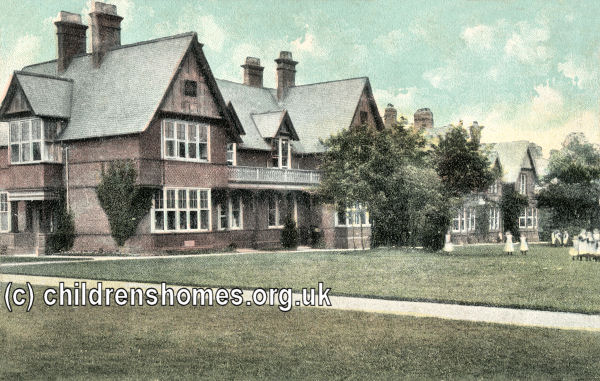
Northumberland Village Homes for Girls from the south, Whitley-on-Sea, early 1900s. © Peter Higginbotham
On 25th February, 1897, , Mrs Craig resigned as superintendent after almost seventeen years in charge of the Homes. She was succeeded by Mrs Bell. The laundry had now developed into a regular and extensive business, with weekly takings averaging £10 to £15. It was mainly carried on by about 16 girls, whose period of committal had expired and who received small wages. An inspector expressed concern, however, that the hours were long and imposed a severe strain on growing girls.
By 1898, Swedish drill and extension motions were being taught. The drill sergeant from the Wellesley instructed the girls in drill once a week. Books were given out every week in the school-room and taken 'home' by the girls. Two girls were punished in June for attempts to abscond, and three others in September and December 1897 for untruthfulness and insolence. The punishments consisted in being deprived of a treat, or having bread and water for dinner. In the school-room, seven girls received 3 or 4 strokes for disobedience, pilfering, or copying, and 44 cases of smaller punishments were recorded.
On 13th August, 1902, the Home were accredited as a Certified School, allowing the admission of girls boarded out by Boards of Guardians.
Miss Julia James was appointed superintendent on 13th June, 1904 in succession to Mrs Bell. Miss James resigned in 1907 and was replaced by Miss M. Brigham. It was reported in that year that thirteen of the older girls had taken sick nursing classes and passed the St John's Ambulance Association examination. The girls had also enjoyed a number of picnics, parties and concerts, and taken walks into the town. There were now 112 girls at the Homes, of whom 67 had been placed by the workhouse authorities.
On October 21st, 1911, Miss Brigham was succeeded as superintendent by Miss C. Lamont.
In 1914, in an effort to improve the physical fitness of the girls, the premises previously used as laundry were converted into gymnasium and play room, and a smaller room into a class and technical instruction room for the older girls.
During the first World War, local Soldiers and Sailors' Families Associations and other institutions were able to make use of the Homes to house the daughters of soldiers who were away on active service. The girls at the Homes also made articles to send to the troops.
On July 20th, 1920, the superintendent's house was certified an Auxiliary Home for the homes, accommodating up to seven girls. The Auxiliary Home acted as a residence for those making the transition back to independent life, or who were between situations. This arrangement was ended in January 1922. In May, 1925, the official capacity of the Homes was reduced from 140 to 120 places. Shortly afterwards, on July 14th, 1925, the Homes were re-certified to also accommodate boys below the age of 12 years, with the total number at places remaining at 120.
In 1933, The Homes became an Approved School, one of the new institutions introduced by the 1933 Children and Young Persons Act to replace the existing system of Reformatories and Industrial Schools. The School accommodated up to 120 Junior Girls aged below their 15th birthday at their date of admission. Small boys were also admitted 'in exceptional circumstances'. In June, 1935, the total capacity of the premises was reduced to 110 places. In 1936, the headmistress was still Miss Lamont.
A large new block was subsequently erected at the south of the Homes' site.
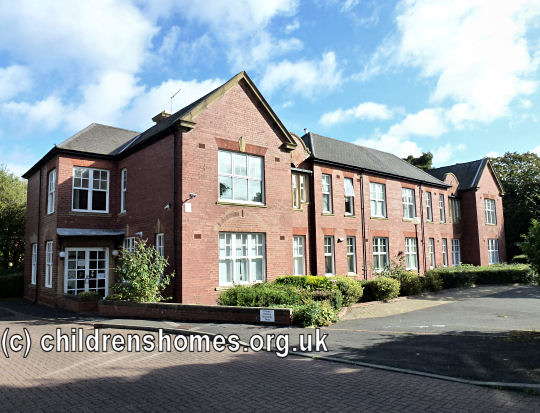
Former Northumberland Village Homes, Whitley Bay, 2013. © Peter Higginbotham
In around 1973, the school became a Community Home with Education (CHE) under the control of Tynemouth County Borough Council.
The Homes closed in March, 1985, and the houses then converted to private residential use.
The body that ran the Homes has now become the Northumberland Village Homes Trust and provides grants for young people under the age of 21 who living in Tyne and Wear, Durham, Cleveland or Northumberland.
Records
Note: many repositories impose a closure period of up to 100 years for records identifying individuals. Before travelling a long distance, always check that the records you want to consult will be available.
- Tyne and Wear Archives, Discovery Museum, Blandford Square, Newcastle upon Tyne NE1 4JA. Has extensive holdings including: Admission registers (1880- 1982); Discharge registers (1881-1980); Committal orders (1880-1959); Case papers (1880-1933) ;Approved School licensing registers (1948-79); Journals (1942-77); Schoolmistress' monthly report books (1900-1925); Old Girls' visiting book (1908-20); Photographs (1880s-1950s); Management rules (1881, 1894, 1907, 1925); Committee minutes (1879-1950); Dietary scale (1882); etc.
Census
Bibliography
- Higginbotham, Peter Children's Homes: A History of Institutional Care for Britain's Young (2017, Pen & Sword)
- Mahood, Linda Policing Gender, Class and Family: Britain, 1850-1940 (1995, Univeristy of Alberta Press)
- Prahms, Wendy Newcastle Ragged and Industrial School (2006, The History Press)
Links
- Northumberland Village Homes Trust, 4 Middle Street, Corbridge, Northumberland NE455AT.
Except where indicated, this page () © Peter Higginbotham. Contents may not be reproduced without permission.


